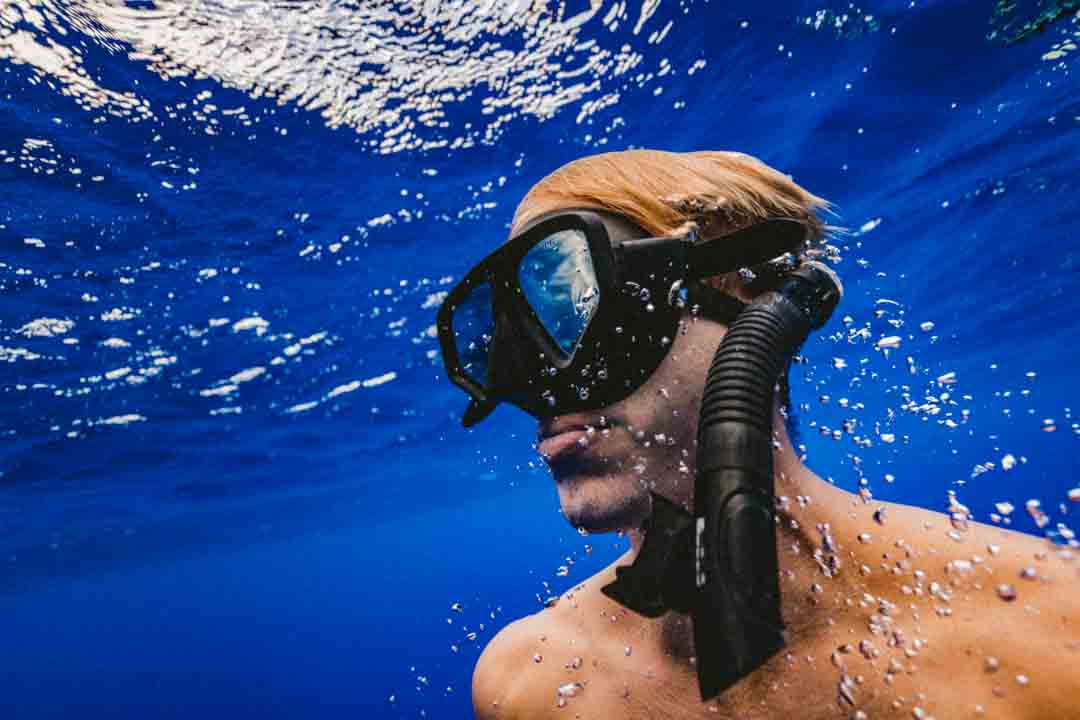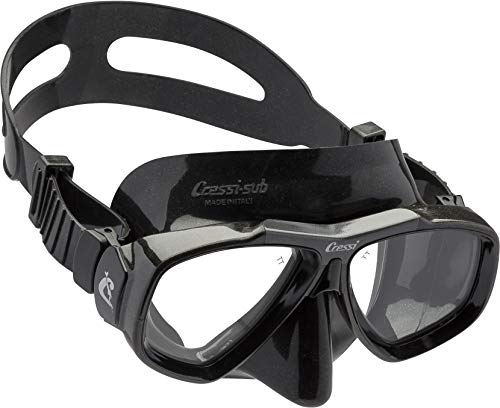In masks, there are two main types: single and twin lenses. Single lenses are composed of a single piece of tempered glass, creating a better view. However, single lenses cannot be changed out for prescription lenses or replaced if broken as twin lenses can. Due to the need for optical correction, every prescription snorkel mask on this list has twin lenses.
BEST PRESCRIPTION SNORKEL MASK IN 2023
ALL THE PRESCRIPTION SNORKEL MASK THAT WE TESTED
SCUBAPRO Zoom
General Impression
The Scubapro zoom diving mask is like a blast from the past with its slightly old-school design. It has low volume dual lenses with a special lens-change system that makes it very easy to switch out with prescription snorkel mask. It has an impact-resistant polycarbonate frame for durability and a hypoallergenic silicone skirt for comfort around the face. The double feathered edge seal provides a tight and waterproof fit.
Prescription Specifications
NEARSIGHTED: -1.00 to -8.00 by 0.5 increments
FARSIGHTED: +1 to +3 (Bi-Focal)
PROS
- Easy to change lenses
CONS
- Sizes might be off
CRESSI Focus
General Impression
It’s no secret that Cressi has some of the best diving masks out there, and everyone seems to agree. The Cressi Focus diving mask is no exception. It’s advertised as one of the first dive masks with inclined glasses. It’s made of a hypoallergenic silicone skirt with a double feathers edge seal that provides a great and comfortable fit around the face. With a prescription from an ophthalmologist, you can get diopter lenses for your Cressi Focus Mask to be the ultimate prescription snorkel mask.
Prescription Specifications
NEARSIGHTED: -1.00 to -8.00 by 0.5 increments
PROS
- High-quality lens
- Multiple colors available
CONS
- Prescription lenses can only be done at a Cressi physical store
TUSA Freedom Ceos
General Impression
The Tusa Freedom Ceos diving mask is one of the best when it comes to a prescription snorkel mask. It has a two-window teardrop design, equipped with the superior and latest Freedom technology to ensure the best fit and comfort. The head strap is Tusa’s patented 3D design, making it sit comfortably around the natural shape of the head. It also features a quick-adjust Buckle system for a fast and easy fit.
Prescription Specifications
NEARSIGHTED: -1.00 to -8.00 by 0.5 increments
FARSIGHTED: +1 to + 4.5 by 0.5 increments
PROS
- Superior technology
- Wide range of colors available
CONS
- RX lenses need to be purchased separately
IST ProEar
General Impression
The IST ProEar diving mask is truly one of a kind. Not only does it protect your eyes, but also your ears so it’s especially good for those who have trouble with pressure. The ear covers are made of soft silicone, creating a watertight seal to protect your ears from pressure. With the special equalization tubes, you can simply exhale through your nose and equalize the pressure, if you feel any. It comes in both adult and junior sizes and is also compatible with the Pro Ear Hood for prescription snorkel masks.
Prescription Specifications
NEARSIGHTED: -1.00 to -8.00 by 0.5 increments
PROS
- Superior technology for protecting your ears and equalizing pressure
CONS
- RX lenses need to be purchased separately
TUSA TM-5700 Liberator Plus Scuba Diving Mask
General Impression
Tusa’s TM-5700 Liberator Plus Scuba Diving Mask has visual options for nearsighted people, including the MC-5000 corrective lenses which range from -1.5 to -8.0 by 0.5 increments. This prescription diving mask has a two-window design with a large field of view and low volume for a great fit and easy equalization. Many users have reported that the prescription mask has no fogging issues once the mask is treated with either de-fog or baby shampoo. Also noted is that the prescription swimming mask has minimal to no leaking. This optical mask comes in five color options: black frame/transparent skirt, black frame/black skirt, cobalt blue frame/transparent skirt, yellow frame/transparent skirt and translucent frame/transparent skirt. This Tusa prescription snorkel mask comes with a three-year warranty.
Prescription Specifications
NEARSIGHTED: -1.5 to -8.0 by 0.5 increments
PROS
- Fits both smaller faces as well as wider faces or wider nose bridges
- Users report this mask has no fogging issues once treated
- Users note there is minimal to no leaking
- Has a three-year warranty
CONS
- Over time, some yellowing may occur in its transparent skirting
PROMATE Scope
General Impression
When it comes to prescription snorkel mask, Promate is the king. The Scope mask is made from a liquid injected silicone skirt and strap that ensures a secure but not too tight fit around the face. The lenses are made from high-quality tempered glass and users have reported very clear vision underwater with them. The prescription optical lenses go from -1.00 to -10.00 for nearsighted and +1.00 to +4.5 for farsighted. There’s also an option for bifocal lenses with measurements from +1 to +4.0 and Gauge reader.
Prescription Specifications
NEARSIGHTED: -1.00 to -10.00 by 0.5 increments
FARSIGHTED: +1 to + 4.5 by 0.5 increments
PROS
- Lens Quality is excellent
- Consultation available before purchase
CONS
- Side release on the mask can be tricky
BEST PRESCRIPTION SNORKEL MASK
Buyer's Guide
MASK DESIGN
Prescription Lenses
There are three main types of prescription lenses someone can order — nearsighted, farsighted and bifocal. Nearsighted optical corrective masks tend to come in -1.0 to -10.0 by 0.5 increments. Farsighted optical corrective masks usually come in +1.0 to +5.0 by 0.5 increments. Bifocal masks may come in +1.0 to +4.0 by 0.5 increments. When buying prescription snorkel mask, be very sure to read up on the specifics required by the dealer to get the necessary mask. Often, different values can be given for each piece of glass — one for each eye — but that needs to be specified in the manner which the seller requires. Make sure to comb the prescription snorkel mask reviews to find how a seller can meet diving and visual needs. Otherwise, a buyer may end up a mask they can only partially see out of at best, and not see out of at all at worst.
Field of View
The field of view (FOV) is the vertical and horizontal degree a specific mask allows you to see underwater. Rectangular or round lenses often increase horizontal FOV. An example of this type of mask is the Promate Optical Corrective mask. The other popular type of lens shape is an inverted teardrop shape with a raked design. A raked design allows the bottom of the lenses to sit closer to the cheek than at the top, which improves the downward view by making the mask bottom less visible. An example of this mask type is the IST Prescription mask.
Fit
After the prescription snorkel mask lenses, the fit of the mask is the next most important element. A great fit is crucial to keeping the mask from leaking and lenses from fogging. As such, a great fitting mask can help keep dives free from distractions, creating the best experiences possible to encourage further diving or snorkeling in the future. To know if the mask fits a face well, hold it up and align it to the nose without using the strap. Breathe in. If the mask holds to the face on the breath in, then that’s a good indicator that it will form a nice seal underwater.
Frame
Masks have two main frame types: framed and frameless. Frameless masks have lenses directly molded to the silicone skirt, streamlining the design while improving the ability to fold flat, usually creating low internal volume. This type of mask is popular with freedivers, especially. On the other hand, framed masks have a rigid framed form which is used as a backbone for the skirt, buckles, and lenses to attach to. Framed masks can often be fit with prescription lenses, which is why every prescription snorkel mask on this list has a frame.
Internal Volume
The internal volume of a mask is the amount of airspace inside of a mask when it is on a face. The more internal volume there is, the more air there is to be compressed when descending, leading to an increased need for equalization. A low-volume mask usually has the lenses close to the eyes, increasing FOV while decreasing internal volume. Freedivers and spearos use their held air to equalize so a mask having small internal volume is crucial to staying down longer for each breath. For example, the Tusa TM-5700 Liberator Plus is a low-volume mask.
Skirt
The skirt is usually made from hypoallergenic silicone, which is soft enough to provide comfort and form to the face to prevent leaks. It is what keeps a person’s face dry while allowing them to equalize. Clear skirts, also called transparent skirts, are ideal for letting in more light to the eyes and decreasing any sense of claustrophobia a person may be feeling in the water. Meanwhile, opaque skirts, such as black, focus the view by minimizing distractions and glare. That’s why freedivers, spearos, and photographers tend to prefer dark opaque skirts over transparent ones.
Straps and Buckles
Another feature of a mask is the strap and buckle system. A mask strap should be able to stretch enough that minor adjustments can be made easily throughout a dive. Also, strap covers are recommended for divers or snorkelers with long hair which could tangle up in the strap. Another thing to check is that the strap buckles can be handled easily, even when wearing dive gloves.
Purge Valve Masks
To get certified, all divers should be able to clear their masks. However, some scuba divers simply don’t like doing it. The answer to that lies in a dive mask with a purge valve under the nose. These types of masks allow a diver or snorkeler to clear out a mask by blowing out of their nose. For example, the Promate Prescription Combo Set features a mask with a purge valve. Please note, however, that purge valves may clog or malfunction, resulting in a potential leaky mask.
MASK USE
Leaks
One of the most common complaints people have about a mask is that it leaks. Often, it may be that the mask is ill-fitted. Make sure that the mask is formed for face type, whether the diver has a small, narrow or round face. This also applies to instances of high or wide noses and foreheads, which can cause discomfort in certain masks. Other than ill fit, another reason for leaks may be that there is a hair which has come under the skirt. Make sure to sweep strands away. For beards, try a mask with a smaller sub-nose seal. In general, loosening the mask strap can help with leaking as well as equalization problems.
Fog (New Mask)
New masks usually come with a silicone film acquired during the manufacturing process. To remove that film, use a soft cloth to rub white toothpaste in circles on the dry glass. Rinse, dry and repeat.
Fog (Used Mask)
Often, a mask may fog up due to body heat and humidity creating condensation. A popular means to de-fog a mask is to use treatment solutions such as a baby shampoo-water mix (baby shampoo won’t sting your eyes) or spit.
Maintenance
After a dive or swim, rinse the mask in warm freshwater and let it dry completely before packing it away. Make sure not to bend or squash it in storage, or it could lead to skirt disfigurement or frame distortion – neither of which are good for the durability of the mask. Also, make sure to regularly check the skirt, straps, and buckles for signs of fine cracks. If spotted, replace that part immediately. If that part cannot be replaced, then it is time for a new mask.
REACH OUT
As always, we create our content with you, fellow adventurers, in mind. So, how’d we do? Did you find this informative? Did it help you make a decision? Did we miss anything? We’d love to hear from you below. Thanks for reading and we hope your next adventure is a great one!























